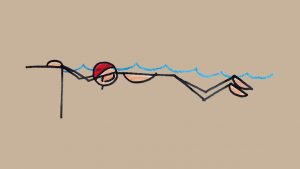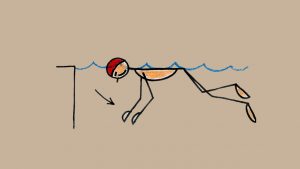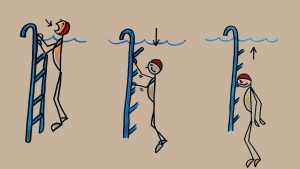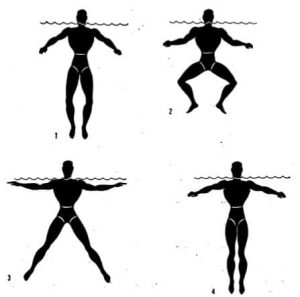AQUAPHOBIA: how to be CONFIDENT where I don’t belong

The Water Mirrors by Maria Svarbova
LOSE YOUR FEET
What about you? Are you afraid to swim where you have no foothold (leave me a comment) and if so why?
In short, what are your emotions when you cross the boundary of the big bath? Are you anxious, excited about pushing yourself, comfortable but tense, or clinging to the edge and looking at the bottom?
I know, you are afraid to go down to the bottom for fear of being absorbed by it (unconscious fears).
In these conditions, on an emotional level it is mainly terror (a fear mixed with a deep feeling of powerlessness), shame linked to an experience of humiliation (for example when you were pulled out of the water and met the amused gaze of others) or a feeling of guilt that dominates.
However, this guilt gives way to anger when the person realises, years later, that he or she has been abused.
PSYCHOLOGY
It should be noted that the conscious and the unconscious are permanently mixed up when it comes to water phobia. The border between the two is blurred, very blurred.
Every time you go to the depths, you feel like you are regressing, suffocating and in turmoil? This feeling is hard for you to bear but the solution is close.
I don’t know your story but if you have :
- apprehension about going swimming at a depth of 2 metres
- the fear of walking away from the wall
- fear of leaving the ground
- hate going into the deep end because you don’t know how to get back to shore
, then your emotional stability is still to be improved with effective technical and kinesthetic tools.
So NO panic! It will come in the next few weeks, but before that, I’d like to share with you a few specific points so that you have more elements of understanding. It’s a gift!
RECOGNISE & BE REBORN
Firstly, this anxiety is positive because, de facto, you are not trying to hide it under a misplaced ego! Besides, this would be the worst attitude to progress.
Moreover, the second advantage of accepting this emotion is that it allows you to identify your deepest needs in swimming.
In short, if you are afraid to go into the deep end, it is because you have understood that you lack the propulsion tools to access autonomy. This gives you a powerful sense of security.
With this information, you can begin a learning process in coherent steps (e.g.: immersion with exhalation, release, leaving your feet off the ground, letting yourself float, etc.).
But before going any further, I would like to know what causes your fear of water. It’s true, it’s important to know even if you don’t have to dwell on it for ages.
PERSONAL HISTORY
So, tell me what causes your blockages in the deep end. I’m listening, were you pushed to the 2 meters when you were a child? Did you drink the cup and scare yourself to death that day? I’m curious, but I assume so.
Or maybe… you don’t know! All you can say is that your parents hate swimming…
Yes, maybe it’s a transgenerational fear. If you have seen your mother or grandmother, for example, uncomfortable or having a panic attack in the pool, your cellular memory has recorded it.
Naturally, years later, it is difficult (or painful) for you to explain to your friends why you always refuse their invitation to go to the sea in the summer (because nobody knows about your disability).
My students often tell me the same story: a friend pushed it, thinking it would make them laugh. It’s true that this joke is excellent…but for the other one!
Anyway, if you’ve started swimming lessons, I hope your lifeguard is in the water with you for the first few sessions.
In this respect, if you read my articles or/and if you have read my book, then you know that I often insist on this indispensable proximity. I won’t go into the reasons why here but the results are amazing when the coach is by your side.
Finally, before we leave, I would like to share with you 3 recommendations from my experience and observations. They will help you to move towards the big bath with serenity and confidence.
In fact, just by observing, I have been able to improve my coaching techniques. And without the commitment, willingness and energy of my students, I would not have the incredible results I have today. Thanks to them!
LETTING GO
Everything you learn in the shallow end of the pool in terms of floating, immersion and movement techniques will be applicable and transferable to the deep end.
In fact, the objective is to improve your swimming in the shallow end with mobility exercises (from front to back and back to stomach), do little “duck dives”, put your head under water, touch the bottom even at 1 meter.
Is this good news for you? Yes, as long as you are muscularly relaxed and let go (do not expect immediate results).
For these reasons, it is reasonable to set a goal but not to cling to it (e.g. wanting to dive to 2 metres in less than two sessions) like a pit bull to a branch.
On the contrary, “do what you have to and come what may” is a good approach to overcome aquaphobia. The advantage is that you don’t put any pressure on yourself (e.g.: I have to be able to swim before the holidays) and moreover you are in the moment at each session.
Oops! I forgot to mention an important fact: your learning process in the shallow end AND in the deep end will not be the same…emotionally.
Besides, if you’ve ever ventured where you can’t set foot, you know what I mean. Your heart starts beating at 140 beats per minute and your intimate history with the water (the big files!) magically reappears.
So, in order to make your stay in the deep a delightful artifice and a total success, I invite you to :
- focus on your muscle relaxation
- give as much of yourself as you can without expecting rapid progress
- be aware that the big bath is the last step before your aquatic autonomy, congratulations for your journey!
- Have fun in the small pool before and after the big bath
Also, take a screenshot of the following to keep these tips with you!
GAINING ALTITUDE
Once in the deep end of the pool (at least 2 metres), take a deep breath with both hands on the edge of the pool before holding your breath.
Slowly lie down on the water (think of it as your bed!) and let go of your neck and arms (always keep your hands on the edge).

This way, you will observe the ground and imagine that you are floating in the air. This feeling of lightness and altitude will give you wings!
In fact, my students sometimes tell me that they feel as if they are looking at the earth from space. Now you don’t have to struggle to stay on the surface of the water. There is a sense of calm and well-being.
Think about the pleasant moments you have spent with your loved ones over the past few weeks.
As a result, you become aware that your lungs are your own life jacket. This sensory information is added to your aquatic library, your kinesthetic toolbox.
Only if you feel up to it, let go of your hands and rest!

ON A LARGE SCALE
Along the ladder of the big bath, you will have fun going down to the bottom by touching the ground while exhaling. In addition, you will push hard with both feet on the floor to get back to the surface quickly.
Under these conditions, you now know that the firm ground on which you are leaning is an ally, I would even say a friend on whom you can count. This is a discovery for you, you are gloating!
Yes, I know what you’re thinking… A few days ago you were afraid to go down to the bottom, for fear of being absorbed by the bottom (unconscious fantasy), and today you’re smiling about it.
Finally, you have the possibility to repeat the experience by keeping the air in your lungs. Go crazy, let go of the ladder once you’re down and you’ll look like a helium-laden hot air balloon on the way up!!!

A sense of security and freedom will be evident on your face with this fun exercise.
AQUATIC LEVITATION
So, if there is one question I have been asked hundreds of times, it is probably this one:
“Thierry, how do you stay upright for a few seconds, with your head above water?”
Honestly, once mastered, this posture will forever eliminate your aquaphobia in general and your anxiety where you have no footing in particular. I’m exaggerating a bit, but you won’t be the same afterwards.
OK, but how do you keep yourself as straight as an “i” on the surface, and more importantly, for what?
Good question!
First of all, I absolutely teach this figure to my students because it allows them to :
- move from stomach to back
- breathe for a few seconds and recover if you are far from the edge
- to avoid a person coming from the front (I often see this in my pool!)
- sit up to put on their glasses and/or get a full view of their surroundings
- to have control over your breathing
For this, it is best to learn the front breaststroke. This vertical position in motion is actually breaststroke…but standing!

FM 20-21 : War Department Field Manual, 1946 Swimming Exercices
Therefore, in the shallow end of the pool, you will practice breaststroke scissors and circular arm movements.
Then, this time in the deep end, you start with your legs holding the edge. When you feel it, release one hand (accelerating with your legs) and then the other to do your vertical breaststroke.
Exhale hard when you push on your legs, it will prevent you from asphyxiation!
Finally, don’t go faster than the music, there’s no point, a plant doesn’t grow in two days, does it? Take your time, cool.
Well, you can already start by floating in the big one by hanging on to the edge tomorrow (cancel the pony and go to the pool!!!). But I’m looking forward to your comments now.
Action!

Thierry Zouaz |


